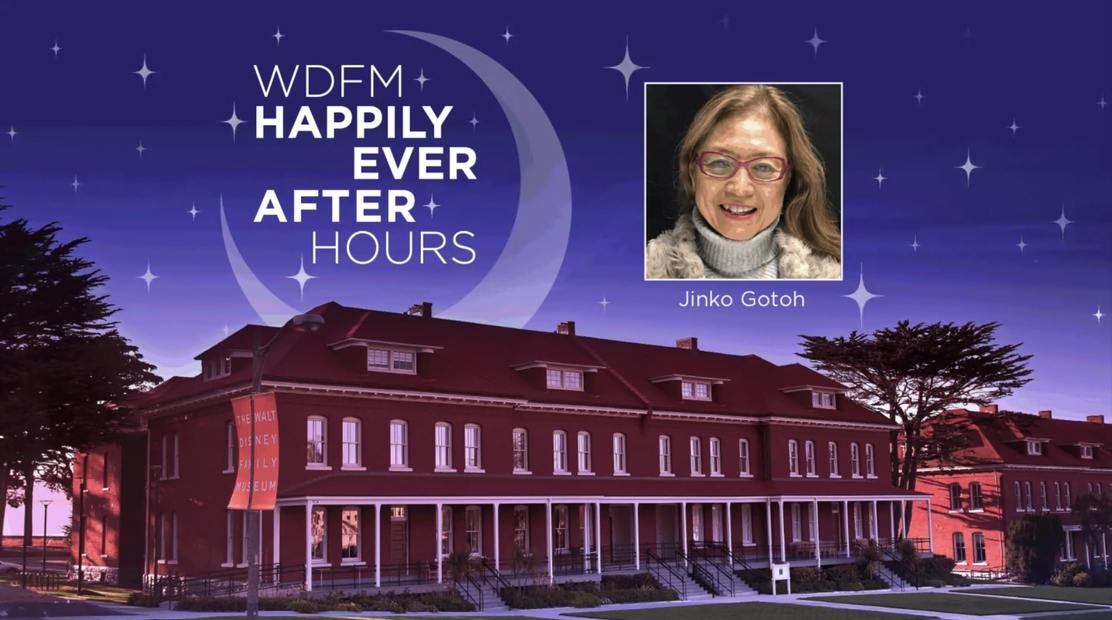Producer Jinko Gotoh was a guest at the Walt Disney Family Museum’s Happily Ever After Hours event on May 8th. The animation producer helped Disney transition to computer animation on Fantasia 2000 and Dinosaur before moving to Pixar on Finding Nemo. Since then, she’s been a mover and shaker in the animation industry, producing award-winning features that include The Illusionist, The Little Prince, and Klaus. Here are ten things we learned from Jinko Gotoh during her Q&A.
1. It all started with Lady and the Tramp.
Growing up in Japan, the first movie Jinko ever saw was Lady and the Tramp and she knew she would one day be moving the the USA. Her father was already there and she thought life in America would be just like the Disney artists depicted in the 1955 animated classic.
2. The creator of Astro Boy made her want to work in animation.
As a young girl in Tokyo, Jinko and her sister met Osamu Tezuka, a doctor who created the character of Astro Boy, Japan’s first animated series to become a worldwide phenomenon, still inspiring modern anime creators. The Japanese animation legend gave young Jinko a few animation cels and a background, which she still treasures today.
3. Her father made her study another field.
Animation was not a practical field to study in the 1970’s and Jinko’s father made her choose another major to fall back on in case animation didn’t work out. She chose mathematics and computer graphics. When she was out of school, her education was most applicable in the aerospace industry, which didn’t interest her. She chose a career in marketing instead, which would lead her back to her passion for animation.
4. She helped Disney shift from traditional to computer animation.
When Jinko joined Disney in the mid-1990’s, the studio had only produced traditionally animated films. She was tasked with helping the studio shift to computer graphics on segments for Fantasia 2000 and the live-action/animation hybrid film Dinosaur.
5. It was challenging to motivate 2D artists to learn the 3D tool kit.
Jinko recognized that there were recent students of animation who knew how to animated in CG, but the artists in the 2D field had years of experience to get the timing right. She was passionate about having 2D artists learn the computer tools to transition to CG, but found many of them to be reluctant. In the end,
6. Software engineers on Dinosaur had to use the system as end users.
The ambitious Dinosaur project required new custom software and Jinko asked the software development team to learn how to work on shots. As they developed the system, they also had to use it to help make sure it was working properly for the animation teams.
7. The animation pipeline changed with the switch to computer animation.
One of the biggest lessons learned while helping Disney transition to computer animation was a change in the production pipeline. In 2D animation, the layout department needs to compose a shot before the animators can begin their work so they know where to draw the characters in relation the the background. In computer animation, characters can be moved around within a digital world much later in the pipeline and animators can start their work without layout being locked in.
8. Her Disney experience prepared her for the challenges of becoming an animation producer.
While working at Disney, Jinko got to learn how to help each department in the animation process. With a deeper knowledge of their needs, Pixar lured her away as a producer on Finding Nemo. Her advice to people in the animation industry who want to produce is to volunteer in other departments to learn what’s needed to support them.
9. She’s passionate about getting more women into the animation industry.
As the Vice President of Women in Animation, Jinko is working hard to help the animation industry become more balanced through gender equality. She’s watched the industry become more open and inclusive since she started at Disney, where there were only a few female animators on Dinosaur. She sees hope for the future with 60% of animation students today being women and a bigger interest in the medium around the world.
10. She hopes Klaus inspires more studios to produce hand-drawn films again.
Her most recent project was Klaus for Netflix, an ambitious return to hand-drawn animation done in a style that looks almost CG. The film was nominated for Best Animated Film at the Academy Awards and one of the film’s goals was to propel the animation medium forward. She encourages animation students to study hand drawn animation in addition to computer animation and hopes a major studio is inspired to revive the medium.

